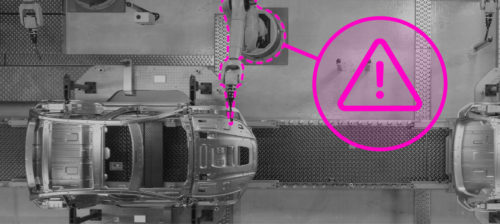Identifying problems from transients in power systems
Utility industry experts estimate that problems resulting from transient overvoltage costs U.S. companies $26 billion annually due to direct damage to electrical distribution systems, electronic equipment, software, tools, and the cost of lost productivity. Electrical transient voltages can originate inside your plant or on the utility grid.
Key Concepts
- Many facility personnel never recognize voltage transients, but notice resulting damage.
- Reducing the magnitude and duration of voltage transients extends the life of equipment insulation.
- Voltage transients caused by capacitor switching typically are more common than those caused by lightning.
- The transient voltage waveforms should be evaluated with a power analyzer or meter with a high sampling rate.
Utility industry experts estimate that problems resulting from transient overvoltage costs U.S. companies $26 billion annually due to direct damage to electrical distribution systems, electronic equipment, software, tools, and the cost of lost productivity.
Electrical transient voltages can originate inside your plant or on the utility grid. They can propagate through various levels of electrical and data systems. Destructive transient voltage sources can be obvious, such as a lightning strike during a thunderstorm, or subtle, such as static discharge from a human finger. At least 60% of transient overvoltage events occur inside the plant; the rest come from outside in the form of lightning and fluctuations in utility power.
Transient overvoltages can stress electrical insulation if its rating is exceeded, leading to abrupt failure or gradual breakdown of the dielectric. Some industrial plants may experience thousands of transients per hour with voltage impulses exceeding 5-10 times the nominal system voltage in some cases (Fig. 1). Surge protective devices (SPDs), sometimes referred to as transient voltage surge suppressors (TVSSs), reduce the magnitude and duration of voltage transients and extend the life of equipment insulation (see “Surge suppression extends equipment life”).
Transient voltage events typically last from less than one microsecond (ransient voltage events appear equally and in phase from each power or signal conductor to ground.
Because the damage from transient voltage events may not be obvious, the cause of a component’s damage is often misdiagnosed and entered on the work order as unknown . As many as 75% of integrated circuit failures can be attributed to voltage transient events. Furthermore, billions of dollars in electronic equipment losses occur each year due to voltage transients, with these casualties increasing each year.
Effects of transients
Engineers can use several factors to characterize voltage transients, including crest (or peak) value, area, energy, maximum rate of rise, duration, and the frequency of the transient. The effect of a transient overvoltage event on a specific load depends on the level of susceptibility of that load to one or more of these factors. The influence of a transient on electronic equipment generally falls into one of four categories:
-
Intermittent interruptions occur when a transient event is introduced into a data or control network resulting in lost or corrupted data. This may cause the load or device to lock up, trip off, or operate improperly. Some factors that affect a transient’s ability to disturb a load include design and operating speed of semiconductors, system filters, grounding configuration, susceptibility to electromagnetic interference (EMI) and radio frequency interference (RFI), and the configuration of the data or control cables.
-
Chronic degradation occurs when repetitive transient events diminish the integrity of an exposed component or components. Over time, the cumulative effect of transient voltage events causes the eventual failure of the vulnerable component. Because the transient voltage events typically are frequent and relatively consistent in this case, it’s feasible for technicians to locate the source with the appropriate troubleshooting tools.
-
Latent failures are similar to chronic degradation, except that they are precipitated by a significant transient event that damages components, but does not cause failure. Normal operation will eventually cause the stressed components to fail. This type of failure is more difficult to troubleshoot because the root cause may have occurred at some unknown point in the past.
-
Catastrophic failures that are caused by transient voltage events usually are obvious because the affected components fail immediately. In those cases, the magnitude, energy, or rate of rise of the transient exceeds the rated threshold of the component, creating a permanent open or short circuit within the component. The probability of correlating component damage with a specific system event is higher with this type of failure.
-
Solid-state products, microprocessor based devices, and programmable logic controllers (PLCs) are especially susceptible to damage from voltage transients. Accordingly, exposure to voltage transients can reduce the reliability and shorten the life of components in this type of equipment. As technology evolves and the scale of these devices shrinks, their susceptibility to damage from voltage transients increases.
Voltage transient events also can affect the quality of the products your plant manufactures. These events can interfere with the normal operation of equipment, resulting in erratic equipment functioning and diminished product quality. Interruptions in continuous manufacturing processes can cause revenue losses due to production downtime.
Sources of transients
The total electrical system includes many devices — both on the utility grid and within the plant.
External sources
Several sources of transient voltages on the utility’s electrical system include:
-
Lightning
-
Capacitor switching
-
Line/cable switching
-
Transformer switching
-
Current-limiting fuse operation.
-
Although voltage transients originating on the utility’s electrical system can affect your plant’s operation, transient voltage sources within the facility are more common.
Internal sources
The normal, daily operation of loads within the plant such as electric furnaces, ovens, induction heaters, welders, or motors can produce voltage transients that may effect adjacent equipment. Within the plant, transformers and motors, which are inherently inductive, introduce transients into electrical systems. Disruptions in the flow of current to these devices concurrently with the collapse of the devices’ magnetic fields cause voltage impulses or transients. Transient voltage sources within the plant include:
-
Capacitor switching
-
Interruption of current to motors, transformers, and other inductive components or equipment
-
Operation of power electronics components such as silicon-controlled rectifiers (SCRs), triacs, etc.
-
Electrostatic discharge (ESD)
-
Arc welding
-
Copy machines
-
Faulty wiring and circuit breakers
-
Contact and relay closure
-
Load startup or disconnect.
-
When a transient voltage event occurs on the utility’s electrical system, the transient overvoltage’s magnitude at a given point within the facility depends on location of the transient source, magnitude of the transient voltage event, configuration of the electrical system, and mitigation devices within the plant.
Transient overvoltages due to capacitor switching are common. When a capacitor bank is energized, a large inrush current charges the capacitors resulting in an initial notch into the voltage waveform. The system voltage recovers quickly, overshoots the original position, and continues to oscillate or ring. System voltage ringing is caused by the resonant circuit created by adding capacitors to an inherently inductive system and typically lasts about 1/2 cycle. Adjustable speed drives are sensitive to this ringing, which could cause them to trip.
Recognizing transients
Because transients have an extremely short duration, many events can either be missed or not accurately quantified because some meters use fewer samples than are necessary to accurately represent the analog signal. The transient voltage waveforms should be evaluated at a high sampling rate to perceive these occurrences. However, standard available metering equipment may not be fast enough to capture transient overvoltage events accurately.
Sophisticated monitoring devices or meters sample the analog signal at a much higher frequency than standard meters. A sample rate of 5 MHz or 83,333 samples-per-cycle (based on a 60-Hz system) during a high-speed event, is considered to be a good rate, compared to 512 (or less) samples-per-cycle in a standard meter (Fig 2). The higher rate results in data that have 162 times higher resolution than the standard available data from a meter sampling at 512 samples per cycle. Because the initial polarity is extremely important in determining the source of (and thus, the solution to) the transient, it is important to provide a high enough resolution to correctly determine the initial polarity of the event. While many longer duration events (such as voltage sags) can be properly diagnosed using lower sample rates, many transient overvoltage events cannot.
Faster monitoring instruments make it easier to determine the sources and effects of transient overvoltages. At a minimum, the voltage transient monitoring instrument should have sufficient resolution to detect and record a transient overvoltage’s true amplitude and duration, as well as the time of the event (Fig. 3).
Recording the time of day is important, because it helps you correlate internally or externally originating transients that occur as a function of the respective system’s operating mode (plant or utility). The leading edge of a voltage transient has a polarity either into the waveform or out of the waveform. With a high-resolution transient waveform capture, you can use the initial polarity of the transient’s leading edge to determine the type of device causing the transient. Given the current and voltage waveform, you can determine the direction — either load-side or source-side of the meter — of the transient source.
Due to metering limitations, and the rapid duration and nonperiodic nature of many transients, you may be unaware of the existence of voltage transients on your electrical system. Eventually, these transients might be responsible for unexplained equipment problems and damage. A myriad of transient voltage sources can affect equipment operation. Transient voltages may originate inside or outside of the plant. To preempt equipment damage and resolve effects of transients, plants should use circuit monitors that adequately measure and represent the true likeness of the original transient waveforms, and devices such as SPDs to mitigate transient problems.
More Info:
If you have questions about transients in plant electrical systems and how to measure and mitigate them, contact the author. Jon Bickel can be reached at bickelj@squared.com . For more information about transients, go to SquareD.com or plantengineering.com . Article edited by Jack Smith, Senior Editor, 630-288-8783, jsmith@reedbusiness.com .
Surge suppression extends equipment life
Surge protection devices (SPDs) have become important components of plant electrical systems because they improve power quality (Fig. 2b). The fundamental functions of SPDs include:
Limiting the damage of electrical and electronic equipment caused by transients in the electrical system that exceed the intended operational characteristics of the equipment
Extending the life of equipment that can be stressed over time due to transients introduced into the power system
Removing transient events before they can affect the power quality of the electrical system in other areas of the plant.
The fundamental function of any SPD is to detect (in a fraction of a cycle) an overvoltage on the electrical system, and divert it in order to protect other equipment on the system. Plant personnel expect that an SPD will perform this function many times over the life of the device. However, the electrical industry recognizes that SPDs may have a limited life in comparison to the plant’s entire electrical system. Understanding a few basics will ensure a better performing and more reliable electrical installation.
Connecting the SPD to the electrical system with the shortest conductor lead possible and minimal bends in the SPD lead provide the most effective protection. SPDs installed as an internal part of a panel or switch should provide the optimal design, which ensures:
Impedance in the conduction path is minimized
Protection levels do not become a variable based on the proximity of the SPD outside the equipment
Conductor length and configuration characteristics are no longer an installation issue.
Connection requirements for an SPD at the service entrance are clearly defined in the 2002 NEC (Article 285), but those requirements continue to be misunderstood.
To ensure a properly protected and reliable electrical system with enhanced power quality, you need a basic understanding of SPD design and application as a component of the overall electrical system. To achieve a reliable electrical system with enhanced power quality, focus on the fundamentals, which include:
NEC-compliant installation — including the short-circuit current rating and the number of disconnects at the service
Performance — appropriate surge ratings, lead length, internally mounted SPDs and placement in the system
UL1449 Listed — meets approved fire and electrical safety testing requirements for SPDs.
-
-
Do you have experience and expertise with the topics mentioned in this content? You should consider contributing to our CFE Media editorial team and getting the recognition you and your company deserve. Click here to start this process.





